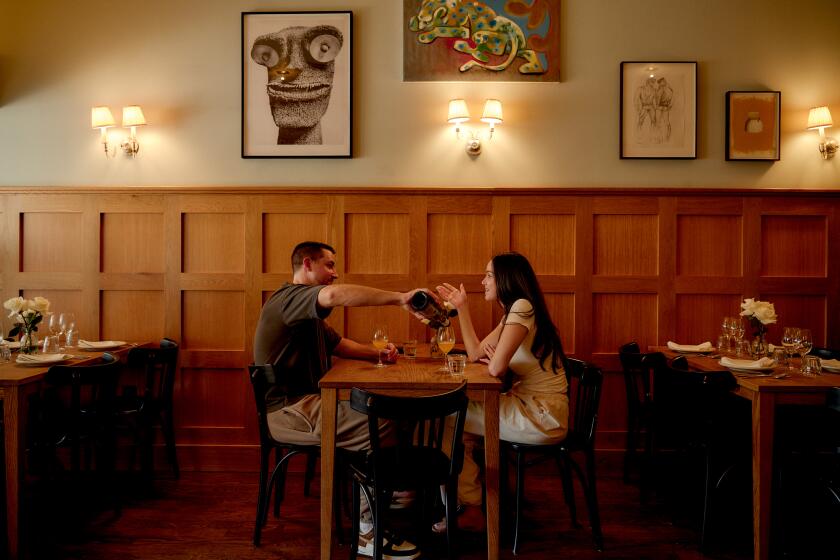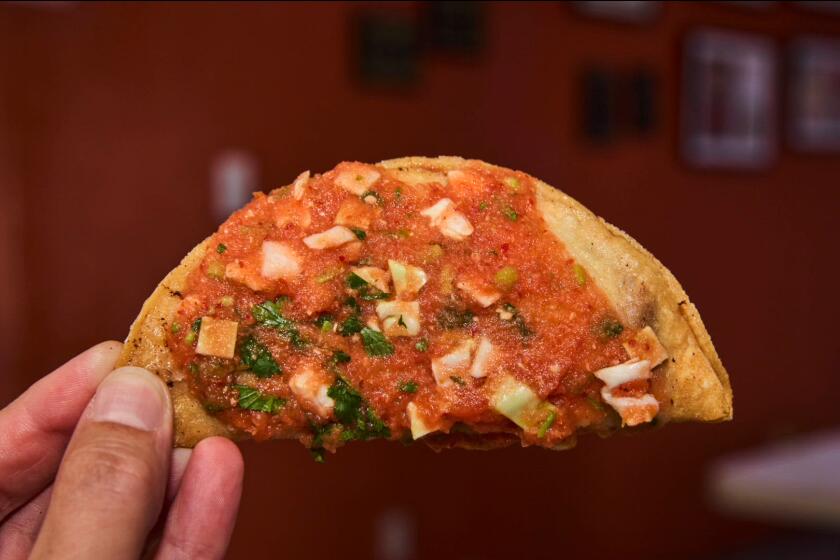Oranges 101
When the Los Angeles Times held cooking courses from 1913 through the 1940s, the classes usually centered on a particular theme. One week it might be a certain ingredient, another week a type of ethnic cuisine.
The second class, offered by Bertha Haffner-Ginger on Feb. 13, 1913, featured “Spanish-style” cooking, though she announced at the outset that she was “not going to make the hot dishes such as tortillas, enchiladas, tamales and frijoles.” Instead, she prepared “milder dishes,” including stuffed baked chicken and a salad of avocados (formerly called alligator pears), red cabbage and green chiles.
One year later, on Feb. 14, 1914, it was “Cake Day” at The Times School of Domestic Science. The free public lecture and demonstration taught several hundred students how to mix, bake, ice and decorate with pastry bags so that “a plain loaf cake becomes a thing of beauty.”
“Special classes” of 17 students each also focused on specific lessons. One covered diet and nutrition; another was designed for nurses, explaining cookery for the sick. Held three days a week at The Times beginning in 1913, the small classes provided each student with a stove, work surface and utensils. Ten lessons and a year’s subscription to the paper cost $25; five lessons and a six-month subscription cost $13.50.
Occasionally, Haffner-Ginger would lead groups of students on shopping tours of various local markets and food distributors. Then, back at the Times, she’d demonstrate what to do with the purchases (much as today’s cooking instructors do after visits to fish markets and fresh produce stands).
In her “Spanish-style” class of 1913, Haffner-Ginger called attention to the use of California ingredients, including “Sylmar-brand olive oil from the famous San Fernando olive orchards and the avocados raised in Pasadena, Whittier and other points in Southern California.”
By Feb. 17, 1932, The Times’ cooking school demonstrated “many new and delicious ways to use oranges in cooking.” Clearly, the interest in home-grown ingredients hadn’t waned. In fact, turnout had been one of the largest in recent memory. On Feb. 22, the new director of what was then the Home Service Bureau--Ethel Vance Morse, using the pseudonym Marian Manners--shared results of the class with readers in her weekly “Requested Recipes” column.
“Yes, indeed, the golden orange is versatile,” she wrote. Five days earlier she had prepared orange nut bread, stuffed baked oranges, an orange-ham-noodle ring, orange sponge cake pie and raised orange rolls. Each recipe had been a success, and Manners decided to put the “very popular orange roll” recipe at the top of her column.
Today, we can see why: The rolls are superb. They’re light, fluffy biscuits with a piece of orange baked inside, and they have a delicious orange flavor, enhanced by Manners’ sweet orange butter spread. Serve them for breakfast or as a dessert. They’re sure to become popular all over again.
Raised Orange Rolls
Active Work Time: 30 minutes * Total Preparation Time: 3 hours 10 minutes
Roll
2 cups milk
3 tablespoons butter
2 teaspoons granulated sugar
1 teaspoon salt
1 (0.6-ounce) cake yeast or 1 (1/4-ounce) package dry yeast
1/3 cup lukewarm water
5 1/2 cups flour, plus more for kneading
Oil, for greasing
1 orange, peeled and pith removed, broken into sections
* Heat milk in small saucepan over medium heat until milk is lukewarm to touch and bubbles around edges, 2 minutes; do not let boil. Remove from heat and stir in butter, sugar and salt. Stir occasionally until mixture reaches room temperature.
* Dissolve yeast in lukewarm water. Combine with milk mixture.
* Transfer mixture to large bowl and gradually sift in 3 cups flour, stirring until combined. Beat well 5 minutes. Place dough in greased bowl, cover with dishcloth and let rise in warm area until doubled in size, 1 hour 15 minutes.
* Sift in remaining 2 1/2 cups flour. Turn out on floured board and knead briefly until smooth and elastic. Return dough to bowl and let rise until doubled in size, 1 hour 15 minutes.
* Pat dough out on floured board 3/4-inch thick and cut 10 to 12 rolls with 2 1/2-inch biscuit cutter. Shape remaining dough together and pat out again; cut as many more rolls as you can. Set rolls on greased baking sheet. Using sharp knife, score top of edge roll lengthwise.
* Trim orange segments, slicing in half, if necessary, to make 1x1/2-inch segments. Place 1 piece in center of each roll, gently closing seam back over orange by pressing 2 sides together. Press down firmly on top of each roll.
Icing
1/4 cup (1/2 stick) butter
1/4 cup powdered sugar
Grated zest of 1 orange
* Cream butter on medium speed until fluffy, 1 minute. Add sugar and beat until smooth, 2 minutes. Add zest and combine well. Set aside.
* Bake rolls at 400 degrees 8 minutes. Remove from oven and spoon 1/2 teaspoon butter mixture inside each roll (seams will have split during baking). Return rolls to oven and bake until golden, 7 to 12 more minutes. Let cool slightly, then brush tops with remaining orange-butter.
15 rolls. Each roll: 236 calories; 229 mg sodium; 17 mg cholesterol; 6 grams fat; 38 grams carbohydrates; 6 grams protein; 0.14 gram fiber.
More to Read
Eat your way across L.A.
Get our weekly Tasting Notes newsletter for reviews, news and more.
You may occasionally receive promotional content from the Los Angeles Times.










